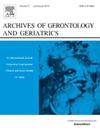Effectiveness of interventions to improve frailty among community-dwelled older adults: A systematic review
IF 3.5
3区 医学
Q2 GERIATRICS & GERONTOLOGY
引用次数: 0
Abstract
Background
Frailty, a geriatric syndrome linked to adverse outcomes, is a significant public health concern in aging populations. This systematic review synthesizes evidence on the effectiveness of interventions, grouped by their components, to reduce frailty in community-dwelling older adults.
Methods
Major biomedical databases were searched for relevant intervention studies from inception to 24 October 2024. Dual screening, data extraction, risk assessment, and synthetic analysis were conducted. Interventions were classified into discrete characteristic components based on the key intervention features identified in the included studies. Findings on effectiveness of interventions were narratively synthesized owing to heterogeneity.
Results
This review included 62 studies (32,364 participants; 76 interventions). Most interventions were multidimensional, and multimodal interventions were found to be effective in improving frailty. The standalone approach of multicomponent or two-component exercise showed potential benefits, while single-component exercise was less likely to be effective. Studies on single-component interventions other than exercise were limited, with mixed results: Nutritional supplements, nutrition guides, art-based activities, and pharmacological agents showed limited efficacy as standalone strategies. Comprehensive educational programs, medical-related care, and cognitive training were scarcely studied but suggested favorable effects on frailty indicators. Limited economic evidence supported cost-effectiveness or cost-saving of interventions addressing frailty.
Conclusions
Current frailty interventions for older residents in the community predominantly relied on exercise or physical activity. Future research should prioritize exploring optimal intervention components or combinations and developing comprehensive intervention strategies, to achieve precise and sustainable improvements in frailty among the broader community-based older populations.
改善社区老年人体质的干预措施的有效性:一项系统综述
背景:虚弱是一种与不良后果相关的老年综合征,是老龄化人群中一个重要的公共卫生问题。本系统综述综合了干预措施有效性的证据,按其组成部分分组,以减少社区居住老年人的虚弱。方法检索各大生物医学数据库,检索自成立以来至2024年10月24日的相关干预研究。进行双重筛选、数据提取、风险评估和综合分析。根据纳入的研究中确定的关键干预特征,将干预措施分类为离散的特征成分。由于异质性,对干预措施有效性的研究结果进行了叙述性综合。本综述纳入62项研究(32,364名受试者;76干预)。大多数干预措施是多维的,并且发现多模式干预措施在改善虚弱方面是有效的。多组分或双组分锻炼的独立方法显示出潜在的益处,而单组分锻炼不太可能有效。除了运动之外,对单一干预措施的研究有限,结果好坏参半:营养补充剂、营养指南、艺术活动和药物制剂作为单独的策略效果有限。综合教育计划、医疗相关护理和认知训练几乎没有研究,但表明对虚弱指标有良好的影响。有限的经济证据支持针对脆弱性的干预措施的成本效益或成本节约。结论目前社区老年居民的虚弱干预主要依赖于锻炼或体育活动。未来的研究应优先探索最佳干预成分或组合,并制定综合干预策略,以在更广泛的社区老年人中实现精确和可持续的虚弱改善。
本文章由计算机程序翻译,如有差异,请以英文原文为准。
求助全文
约1分钟内获得全文
求助全文
来源期刊
CiteScore
7.30
自引率
5.00%
发文量
198
审稿时长
16 days
期刊介绍:
Archives of Gerontology and Geriatrics provides a medium for the publication of papers from the fields of experimental gerontology and clinical and social geriatrics. The principal aim of the journal is to facilitate the exchange of information between specialists in these three fields of gerontological research. Experimental papers dealing with the basic mechanisms of aging at molecular, cellular, tissue or organ levels will be published.
Clinical papers will be accepted if they provide sufficiently new information or are of fundamental importance for the knowledge of human aging. Purely descriptive clinical papers will be accepted only if the results permit further interpretation. Papers dealing with anti-aging pharmacological preparations in humans are welcome. Papers on the social aspects of geriatrics will be accepted if they are of general interest regarding the epidemiology of aging and the efficiency and working methods of the social organizations for the health care of the elderly.

 求助内容:
求助内容: 应助结果提醒方式:
应助结果提醒方式:


